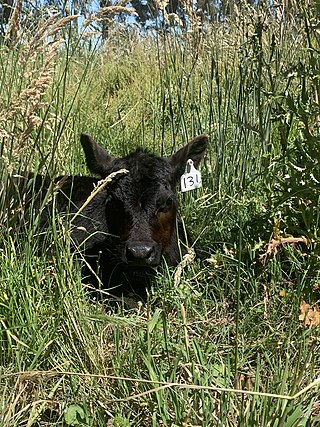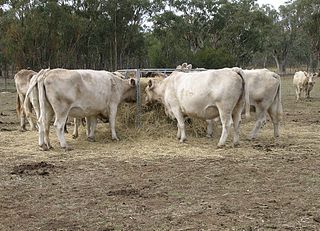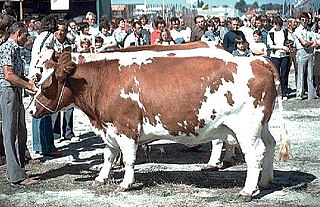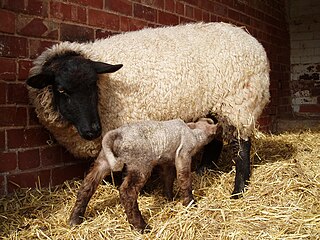
A calf is a young domestic cow or bull. Calves are reared to become adult cattle or are slaughtered for their meat, called veal, and hide.

Horse breeding is reproduction in horses, and particularly the human-directed process of selective breeding of animals, particularly purebred horses of a given breed. Planned matings can be used to produce specifically desired characteristics in domesticated horses. Furthermore, modern breeding management and technologies can increase the rate of conception, a healthy pregnancy, and successful foaling.

Artificial insemination is the deliberate introduction of sperm into a female's cervix or uterine cavity for the purpose of achieving a pregnancy through in vivo fertilization by means other than sexual intercourse. It is a fertility treatment for humans, and is a common practice in animal breeding, including dairy cattle and pigs.

The Holstein Friesian is an international breed or group of breeds of dairy cattle. It originated in the Dutch provinces of North Holland and Friesland and in Schleswig-Holstein in northern Germany. It is the dominant breed in industrial dairy farming worldwide, and is found in more than 160 countries. It is known by many names, among them Holstein, Friesian and Black and White.
Insemination is the introduction of sperm into a female’s reproductive system for the purpose of impregnating, also called fertilizing, the female for sexual reproduction. The sperm is introduced into the uterus of a mammal or the oviduct of an oviparous (egg-laying) animal. In mammals, insemination normally occurs during sexual intercourse or copulation, but insemination can take place in other ways, such as by artificial insemination.
Electroejaculation is a procedure used to obtain semen samples from sexually mature male mammals. The procedure is used for breeding programs and research purposes in various species, as well as in the treatment of ejaculatory dysfunction in human males. This procedure is used frequently with large mammals, particularly bulls and some domestic animals, as well as humans who have certain types of anejaculation. Electroejaculation has also been used for the cryoconservation of animal genetic resources, where semen is stored in low temperatures with the intent of conserving genetic material and future revival.

Semen collection refers to the process of obtaining semen from human males or other animals with the use of various methods, for the purposes of artificial insemination, or medical study. Semen can be collected via masturbation, prostate massage, artificial vagina, penile vibratory stimulation (vibroejaculation) and electroejaculation. Semen can be collected from endangered species for cryopreservation of genetic resources.

A sperm bank, semen bank, or cryobank is a facility or enterprise which purchases, stores and sells human semen. The semen is produced and sold by men who are known as sperm donors. The sperm is purchased by or for other persons for the purpose of achieving a pregnancy or pregnancies other than by a sexual partner. Sperm sold by a sperm donor is known as donor sperm.

A stud animal is a registered animal retained for breeding. The terms for the male of a given animal species usually imply that the animal is intact—that is, not castrated—and therefore capable of siring offspring. A specialized vocabulary exists for de-sexed animals and those animals used in grading up to a purebred status.

Murnau-Werdenfels Cattle are an old, robust dairy breed from Upper Bavaria, the southernmost part of Germany.

The Australian Charbray is an Australian breed of cattle derived from a cross between the French Charolais cattle and American Brahman cattle. The charbray breed was first conceived in the United States of America in the 1930s and later introduced into Australia in 1969. In Australia, Australian charbray breeders are concentrated in the tropical Northern regions of Queensland. As of 1977, the official breeder society of Charbray cattle in Australia and New Zealand is the Charbray Society of Australia Limited, responsible for recording Charbray cattle in herd books, fostering improvement, enhancement and sales of Charbray cattle.

The Armoricaine or Armorican is an endangered French breed of domestic cattle. It originated in Brittany in the nineteenth century. It has a red coat with white markings, and has short horns.

The Pie Rouge des Plaines is a modern French breed of dairy cattle. It was created in about 1970 by cross-breeding the traditional Armorican cattle of Brittany, in north-western France, with red-pied cattle of the Dutch Meuse-Rhine-Yssel and German Deutsche Rotbunte breeds.

Domestic sheep reproduce sexually much like other mammals, and their reproductive strategy is furthermore very similar to other domestic herd animals. A flock of sheep is generally mated by a single ram, which has either been chosen by a farmer or has established dominance through physical contest with other rams. Most sheep have a breeding season (tupping) in the autumn, though some are able to breed year-round.
Elk farming is an agricultural industry for the production of elk as livestock or for the sport of hunting. Elk have a variety of uses. The velvet antler or, the antler in the premature stages of growth, is believed by some to have medicinal purposes. Elk are also raised for venison, their meat. All of these markets are rising in popularity thus causing an increase in the breeding industry. Other species of similar type are farmed in the same way such as deer, moose, and red stag.
ABS Global, formerly the American Breeders Service, is an artificial insemination company that sells frozen bovine semen. It headquarters are in DeForest, Wisconsin.
A conception device is a medical device which is used to assist in the achievement of a pregnancy, often, but not always, by means other than sexual intercourse. This article deals exclusively with conception devices for human reproduction.
The Animal Reproduction Research Institute (ARRI) may be considered to date back to 1968 when the first center for bull investigation in Egypt was established. Its main responsibilities were the examination of bulls used for artificial insemination or natural breeding purposes, in addition to examining samples received from districts throughout Egypt for diagnostic purposes. long before that time, however, different aspects of animal reproduction were practiced in an informal, and later, formal manner. for example, artificial insemination has been applied in a primitive fashion for hundreds of years. Fresh semen, collected from newly impregnated female animals, was injected into other female animals.

The Artificial Insemination Centre of Quebec (CIAQ) is a limited partnership society founded in 1948 located in Saint-Hyacinthe, Quebec, Canada with the mission of improving through artificial insemination bovine herds used in milk and meat production throughout the province. The CIAQ is currently the sole bovine sperm production facility in Quebec and is the propriety of the Milk Producers of Quebec (PLQ), the Quebec Council of Milk Producing Breeds (CQRL) and the Provincial Council of Cattle Amelioration Clubs (CPCAB).
The Swiss Holstein is the Swiss variant of the international Holstein-Friesian breed of dairy cattle. It results from systematic cross-breeding, through artificial insemination between 1966 and 1973, of the traditional dual-purpose black-pied Fribourgeoise from the Canton of Fribourg in western Switzerland with Canadian Holstein stock.













